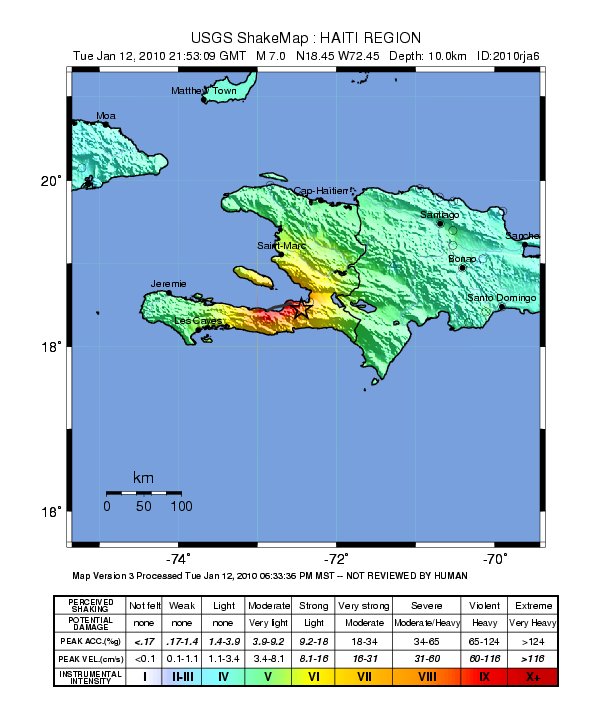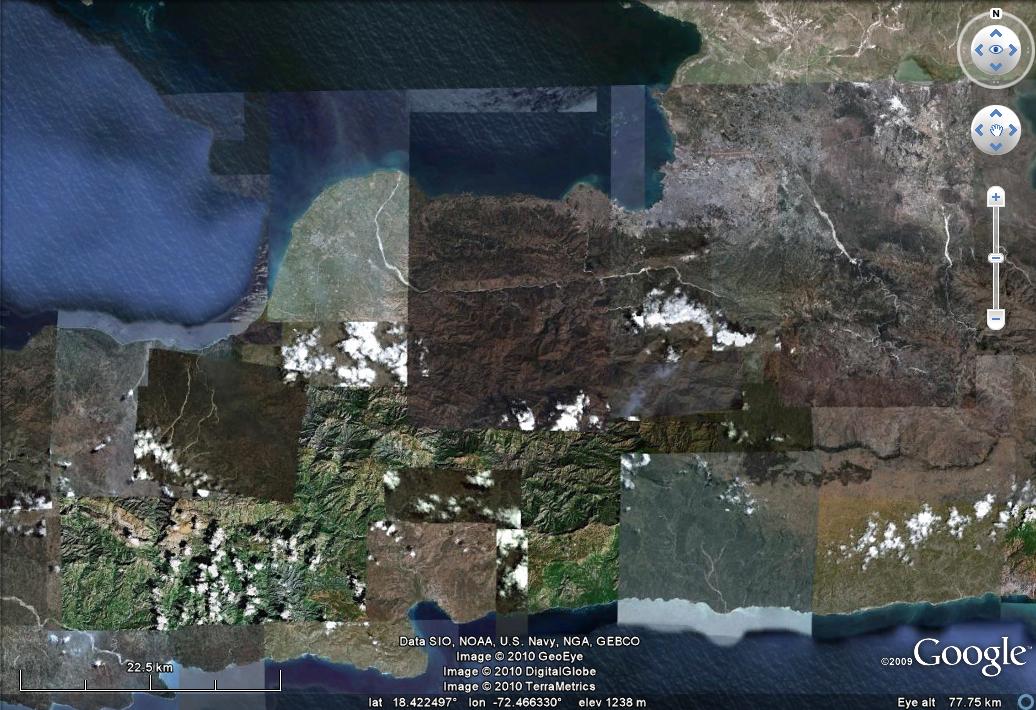13 January 2010
The likely impacts of the Haiti earthquake
Posted by Dave Petley
The earthquake in Haiti is likely to have caused very high levels of damage and many fatalities. The USGS is currently reporting the earthquake as magnitude 7.0 at a shallow depth (only 10 km), which will have led to high ground accelerations for a large area of the country: The USGS PAGER analysis, which examines the vulnerability of the population is the affected area places three large communities (Petit Goave, population = 15,000; Leogane, 12,000; and Grand Goave, 5,000) in the intensity (MMI) = X area and one community (Gressier, 4,000) in the MMI=IX zone. Very worrying in the city of Carrefour (population = 442,000 people) in the MMI=VIII zone and both Port au Prince (population =1.235 million) and Delmas (population = 383,000 people) in the MMI=VII zone.
The USGS PAGER analysis, which examines the vulnerability of the population is the affected area places three large communities (Petit Goave, population = 15,000; Leogane, 12,000; and Grand Goave, 5,000) in the intensity (MMI) = X area and one community (Gressier, 4,000) in the MMI=IX zone. Very worrying in the city of Carrefour (population = 442,000 people) in the MMI=VIII zone and both Port au Prince (population =1.235 million) and Delmas (population = 383,000 people) in the MMI=VII zone.
A reminder of the levels of damage associated with the higher intensities is as follows:
MMI=VIII. Damage slight in specially designed structures; considerable in ordinary substantial buildings with partial collapse; great in poorly built structures. Panel walls thrown out of frame structures. Fall of chimneys, factory stacks, columns, walls and monuments. Heavy furniture overturned. Sand and mud ejected in small quantities. Changes in well water. Persons driving cars disturbed.
MMI=IX. Damage considerable in specially designed structures; well-designed frame structures thrown out of plumb; great in substantial buildings with partial collapse. Buildings shifted off foundations. Ground cracked conspicuously. Underground pipes broken.
MMI=X. Some well-built wooden structures destroyed; most masonry and frame structures destroyed with foundations; ground badly cracked. Rails bent. Landslides considerable from river banks and steep slopes. Shifted sand and mud. Water splashed, slopped over banks.
Needless to say Haiti’s building stock is in general not designed to withstand seismic events.
Unfortunately, Haiti has long featured large in the fatal landslide catalogue. The major issue, as I highlighted in this post from September 2008, is that the hillsides have been stripped bare for firewood, and so are very vulnerable to landslides. Thousands have been killed in mudslides, especially around the city of Gonaives, in the last decade. As the Google Earth image below shows, the area affected by the earthquake is mountainous:

It seems likely that landslides will represent a major problem in the rural areas. The news that emerges from Haiti over the next few days is likely to be very grim indeed. The combination of a large earthquake at a shallow depth very close to major population centres in an essentially failed state that is the poorest country in the western hemisphere is likely to have induced a truly fearsome outcome.


 Dave Petley is the Vice-Chancellor of the University of Hull in the United Kingdom. His blog provides commentary and analysis of landslide events occurring worldwide, including the landslides themselves, latest research, and conferences and meetings.
Dave Petley is the Vice-Chancellor of the University of Hull in the United Kingdom. His blog provides commentary and analysis of landslide events occurring worldwide, including the landslides themselves, latest research, and conferences and meetings.
The situation looks terrible from what I have been reading online and listening to on the news. I hope other countries as well as the United States do anything possible to help the Haitian people.
How do we get info on Petit Goave and any damage there? We have a mission there and cannot find any [email protected]
Looking for information on damage to Petit Goave.